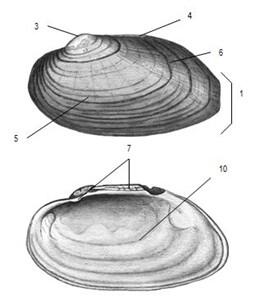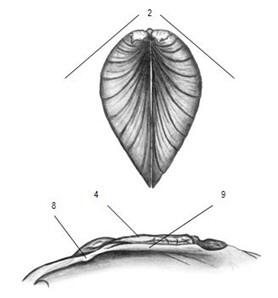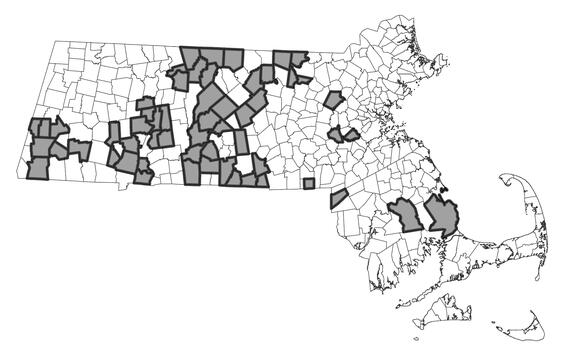- Scientific name: Strophitus undulatus
- Species of Greatest Conservation Need (MA State Wildlife Action Plan)
- Special Concern (MA Endangered Species Act)
Description
Creeper
The creeper is a small freshwater mussel that rarely exceeds 75 mm (3 in) in length. The shape is subovate to subtrapezoidal and usually has a blunt posterior end (1). The shells are slightly inflated (2), thin, and fragile. Beaks (3) are barely elevated above the hinge line (4). Sculpturing on the beak is usually coarse and prominent, but this feature is often only evident in animals with little shell erosion. The surface of the shell is often rough due to prominent growth lines. The periostracum (5) may be yellow or greenish-brown in young animals, and brown or black in older animals. Fine green shell rays may be evident toward the posterior slope (6), particularly in young animals or light-colored adults. Hinge teeth (7) are almost entirely absent; pseudocardinal teeth (8) appear as an indistinct swollen area of the nacre below the beak. Lateral teeth (9) are absent. The nacre (10) is white or bluish-white, and it is dull-yellow or greenish toward the beak cavity. Feet may be a very pale orange color but this trait is variable.
Shells (dead animals) are usually easy to distinguish because they lack hinge teeth and have a distinct color pattern on the nacre. However, these features cannot be used when identifying live animals. The novice will often have difficulty discerning among live animals of the creeper, eastern elliptio, brook floater, dwarf wedgemussel, triangle floater, alewife floater, and eastern floater. Greatest difficulty arises when trying to identify juveniles, animals with excessive shell erosion, or animals whose periostracum is darkly stained or covered with algae. A common error is to confuse the creeper with young eastern elliptio, which unlike the creeper have very strong, thick shells. An expert should be consulted to identify the species because it is listed as a species of Special Concern in Massachusetts and because it can be confused with two other state or federally protected species (brook floater and dwarf wedgemussel).


Illustrations by Ethan Nedeau.
Life cycle and behavior
Freshwater mussels are essentially sedentary filter feeders that spend most of their lives anchored to the bottoms of rivers, streams, lakes, and ponds by their muscular foot. Gills circulate water through their shells via incurrent and excurrent openings, siphoning nutrients to be absorbed by the digestive system. This filtering process is also critical for successful reproduction. Like all freshwater mussels, larvae (called glochidia) of the creeper must attach to the gills or fins of a vertebrate host (mainly fish) to develop into juveniles (for a review, see Nedeau et al. 2000). This parasitic phase is the only period during which mussels can disperse long distances. Fertilization occurs in the summer and glochidia are released the following spring. Studies have identified many vertebrate hosts, including a suite of species common in cool to warm-water streams in Massachusetts such as largemouth bass, fallfish, longnose dace, blacknose dace, common shiner, golden shiner, slimy sculpin, bluegill, rock bass, and even two-lined salamanders and red-spotted Newts (Nedeau et al. 2000, Gray et al. 2002). Gray et al. (2002) found a low degree of host specificity, host generalist, for the creeper; its glochidia successfully metamorphosed into juveniles on 15 of the 22 species examined. Because the creeper will parasitize such a broad range of native and non-native fish species in Massachusetts, its viability may be less reliant on specific fish as compared to other mussel species, such as the dwarf wedgemussel, which is host-specific. Lefevre and Curtis (1911) found that glochidia of the creeper could transform into juveniles without a fish host, a trait that is rare among freshwater mussels. This observation has not been confirmed.
Distribution and abundance
The creeper is widely distributed in North America. It occurs in most Atlantic coastal drainages from Florida to Newfoundland and occurs west of the Appalachian Mountains to Texas and Saskatchewan (including the St. Lawrence River system, Great Lakes basin, and the Ohio and Mississippi River systems). In Massachusetts, the creeper is present in the Housatonic, Farmington, Westfield, Middle Connecticut, Chicopee, Millers, Quinebaug, Blackstone, Nashua, Concord, Charles, and Taunton River watersheds with most occurrences in central and western MA.
Although the creeper is widely distributed in Massachusetts, it is never abundant and the long-term viability of low-density populations is poorly understood. Therefore, the creeper is listed as a species of Special Concern in Massachusetts pursuant to the Massachusetts Endangered Species Act (MG.L. c.131A) and its implementing regulations (321 CMR 10.00).

Distribution in Massachusetts.
1999-2024
Based on records in the Natural Heritage Database.
Habitat
In northeastern North America, the creeper inhabits small to large rivers. Preferred habitats include low-gradient river reaches with sand and gravel substrates and low to moderate water velocities, although they can occur within a broader range of habitat conditions (Nedeau et al. 2000, Skorupa et al. 2024). While the creeper has not been reported from lakes in the Northeast, they often inhabit small impoundments of run-of-river dams that retain some amount of flow. Streams and rivers that are productive, cool to warm-water environments with diverse fish assemblages are most likely to support the species. Creepers are generally sparse or absent in headwater streams and high-gradient river reaches. They occur most frequently with eastern elliptio, triangle floater, dwarf wedgemussel, and brook floater, but have a far broader distribution than the latter two species.
Healthy habitats are vital for supporting native wildlife and plants. Explore habitats and learn about conservation and restoration in Massachusetts.
Stable run and pool habitat for creeper.
Threats
Because creepers are essentially sedentary filter feeders, they are unable to flee from degraded environments and are vulnerable to the alterations of waterways. Some of the many threats to the brook floater and its habitat in Massachusetts include: nutrient enrichment, sedimentation, point-source pollution, road salts, alteration of natural flow regimes, water withdrawal, encroachment of river corridors by development, non-native and invasive species, habitat fragmentation caused by dams and road-stream crossings, sudden release of water and sediment from dam removals, and a legacy of land use that has greatly altered the natural dynamics of river corridors (Nedeau 2008). In addition, the long-term effects of regional or global problems such as acidic precipitation, mercury, and climate change are considered severe but little empirical data relates these stressors to mussel populations. Effects from climate change including extreme flows and sustained droughts, threaten current creeper populations. As local populations of creepers decline and/or become extirpated in response to these threats, dispersal distances between populations increase, weakening overall reproductive success and ultimately genetic diversity (Vaughn 1993).
Conservation
Survey and monitoring
Standardized surveys are critically needed to monitor known populations, evaluate habitat, locate new populations, and assess population viability at various spatial scales (e.g., stream, watershed, state; Sterrett et al. 2018). Survey efforts should continue to search for new populations via physical and potentially eDNA surveys and revisit sites of relatively high viability every five years or to the extent feasible. At a subset of these sites long-term monitoring sites should continue or become established to acquire critical demographic (e.g. survival rates) and trend data. Monitoring these sites should continue to occur annually in multi-year blocks or as needed.
Management
Discovery and protection of viable mussel populations is critical for the long-term conservation of freshwater mussels. Currently, much of the available mussel occurrence data are the result of limited presence/absence surveys conducted at road crossings or other easily accessed points of entry. In addition, regulatory protection under MESA only applies to rare species occurrences that are less than 25 years old. Surveys are critically needed to monitor known populations so that conservation and restoration efforts, as well as regulatory protection, can be effectively targeted. Other conservation and management recommendations include: maintain naturally variable river flow and limit water withdrawals; identify, mitigate, or eliminate sources of pollution to rivers; identify dispersal barriers (e.g., dams, impassable culverts) for host fish, especially those that fragment the species range within a river or watershed; maintain adequate vegetated riparian buffer;and protect or acquire land at high priority sites.
Research needs
Research needs for creeper include population-level data on survival rate, mortality rate, individual growth rates, population size trends, age at reproduction, sex ratio, and age structure. This data will help develop population viability models to identify when populations may need active restoration via introduction of propagated mussels. Additional research is needed within occupied watersheds to address potential current factors limiting distribution and abundance including road salts, ammonia concentrations, beaver activity, and host-fish use. Climate change projections for water temperature and streamflow in occupied watersheds is also needed to assess current and future population risks and identify potential flow refuges during drought and flooding conditions. Further, the role of run-of-river dams supporting relatively high abundances of creeper and other mussel species downstream needs further investigation.
References
Gray, E.V.N., B.A. Lellis, J.C. Cole, and C.S. Johnson. 2002. Host Identification for Strophitus undulatus (Bivalvia: Unionidae), the Creeper, in the Upper Susquehanna River Basin, Pennsylvania. The American Midland Naturalist 147(1): 153-161.
Lefevre, G., and W.C. Curtis. 1911. Metamorphosis without parasitism in the Unionidae. Science 33: 863-865.
Nedeau, E.J. 2008. Freshwater Mussels and the Connecticut River Watershed. Connecticut River Watershed Council, Greenfield, Massachusetts. xviii+ 132 pp.
Nedeau, E.J., and J. Victoria. 2003. A Field Guide to the Freshwater Mussels of Connecticut. Connecticut Department of Environmental Protection, Hartford, CT.
Nedeau, E.J., M.A. McCollough, and B.I. Swartz. 2000. The Freshwater Mussels of Maine. Maine Department of Inland Fisheries and Wildlife, Augusta, Maine.
Skorupa, A.J., A.H. Roy, P.D. Hazelton, D. Perkins, T. Warren, A. Fisk. 2024. Abundance of five sympatric stream dwelling mussels varies with physical habitat. Aquatic Conservation Marine and Freshwater Ecosystems 34(2):e4069.
Sterrett, S. Roy, A., Hazelton P., Watson, B., Swartz, B., Russ T.R., Holst, L., Marchand, M., Wisniewski, J., Ashton, M. and Wicklow, B. 2018. Brook Floater Rapid Assessment Monitoring Protocol. U.S. Department of Interior, Fish and Wildlife Service, Cooperator Science Series FWS/CSS-132-2018, Washington, D.C.
Vaughn, C. 1993. Can biogeographic models be used to predict the persistence of mussel populations in rivers? pp.117-122 in K.S Cummings, A.C. Buchanan and L.M. Koch (eds)., Conservation and Management of Freshwater Mussels: proceedings of a UMRCC symposium, 12-14 October 1992, St. Louis, Missouri. Upper Mississippi River Cons. Com., Rock Island, Illinois. 189 pp.
Contact
| Date published: | March 31, 2025 |
|---|